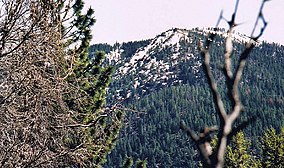Snow Mountain Wilderness
| Snow Mountain Wilderness | |
|---|---|
|
IUCN category Ib (wilderness area)
|
|

Snow Mountain, East Peak, April, 2003
|
|
|
Location of Snow Mountain Wilderness
|
|
| Location | Mendocino National Forest; Lake / Colusa / Glenn counties, California, United States |
| Nearest city | Lakeport, California |
| Coordinates | 39°25′00″N 122°43′19″W / 39.41667°N 122.72194°WCoordinates: 39°25′00″N 122°43′19″W / 39.41667°N 122.72194°W |
| Area | 37,679 acres (152.48 km2) |
| Established | 1984 |
| Governing body | United States Forest Service |
The Snow Mountain Wilderness is a 60,076-acre (243.12 km2) federally designated wilderness area located 65 miles (105 km) north of Santa Rosa, California, USA in the Mendocino National Forest. The U.S. Congress passed the California Wilderness Act of 1984 which created 23 new wilderness areas including Snow Mountain. It lies within the North Coast Range of mountains.
Elevations are from 1,800 feet (500 m) to 7,056 feet (2,151 m). The wilderness covers the crest of this North Coast Range mountain divide for 13 miles (21 km) and the summit area includes two peaks, East (7,050 ft) and West (7,021 ft).
On October 17, 2006 the Northern California Coastal Wild Heritage Wilderness Act was signed into law (Public Law No: 109-362) which added 23,706 acres (95.93 km2) to the Snow Mountain Wilderness. In July 2015, the area became part of Berryessa Snow Mountain National Monument.
The Trough Fire burned 24,970 acres (101.1 km2) of Snow Mountain Wilderness and national forest land in August 2001. More than 12 million dollars was spent to contain the wildfire even though most of the area was within the wilderness boundary. This human-caused wildfire started near Fouts Springs, an off-road vehicle recreational area in Mendocino National Forest.
The Middle and South Forks of Stony Creek flow down the east side of the divide. The west slopes are drained by the main Eel River and the Rice Fork of the Eel. Other tributaries are Bearwallow Creek and Thistle Glade Creek. Stony Creek has a self-sustaining population of wild rainbow trout.
More than 500 species of plants have been identified in the wilderness as well as 122 species of wildlife. The highest elevations have a subalpine environment with barren, rocky slopes and stunted red fir trees, while middle and lower elevations have stands of mixed conifers such as white fir, Jeffrey pine and incense cedar as well as black oak. Mountain-mahogany grows on exposed ridges in the wilderness and is a food source for the black-tailed deer. Rare native plants include Sonoma manzanita (Arctostaphylos canescens ssp. sonomensis) on Snow Mountain East, on St John's Mountain is the endemic annual herb bentflower fiddleneck (Amsinckia lunaris).
...
Wikipedia

